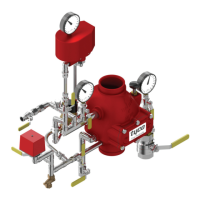Appendix A of TFP1090 (07/2020)
Summary Instructions (if problems occur, consult full document)
DN65 and DN80, Model DPV-1 Dry Pipe Valve with Three-Way Alarm Test Valve,
without Model ACC-1 Accelerator
A
M
L
E
K
J
N
H
F
B
G C D P
I. Normal Conditions
•
The Main Control Valve (A) is opened
and locked.
•
The sprinkler system is lled with air
and is pressurized.
•
The Main Drain Valve (F), and Low
Body Drain Valve (L) are closed.
•
The Three-Way Alarm Control Valve
(E) is in the open position.
• The Pressure Gauge Valves (B) and
(C) are open.
•
The Pressure Switch Valve (J) is
open.
• The Air Supply Control Valve (K) is
open.
•
System Air Pressure Gauge (G)
reads downstream air pressure.
•
Water Supply Pressure Gauge (H)
reads the upstream water pressure.
II. Operation
When one or more sprinklers are acti-
vated, air pressure is reduced down-
stream of the Dry Pipe Valve. When the
air pressure is sufciently reduced, the
water pressure overcomes the differen-
tial holding the Dry Pipe Valve closed
and the Dry Pipe Valve opens to per-
mit water ow into the system piping
and to be discharged from any open
sprinklers. Also, with the Dry Pipe
Valve open, water ows through the
Alarm Port at the rear of the Dry Pipe
Valve to actuate the Waterow Pressure
Alarm Switch (M) and, as applicable,
the Water Motor Alarm.
III. Removing System From Service
Step 1.
Close the Main Control Valve
(A), close the Air Supply Control Valve
(K), and place the Three-Way Alarm
Control Valve (E) in the closed position.
Step 2.
Drain the system with the Main
Drain Valve (F) and by opening all auxil-
iary drain valves in the system to make
sure that cross-mains and branch lines
are drained.
IV. Placing the System Back in
Service
Step 1.
Close the auxiliary drain valves
after water ceases to discharge, and
leave the Main Drain Valve (F) open.
Step 2.
Place the Three-Way Alarm
Control Valve (E) in the open position.
Step 3.
Replace the sprinklers that
have operated and the sprinklers close
to the re.
Step 4. Push down on the reset knob
(P) to allow the Dry Pipe Valve (D) to
re-seat.
Step 5.
Via the Air Supply Control
Valve (K), pressurize the system with
air to 0,7 bar, and then open and close
each auxiliary drain valves in the sys-
tem piping to drain any remaining water
in trapped sections. Also, partially open
the Low Body Drain Valve (L) to assure
that the riser is completely drained.
Close the Low Body Drain Valve (L) as
soon as water ceases to discharge.
Step 6.
Open the Air Supply Control
Valve (K) to restore the system to the
normal system air pressure.
Step 7.
Partially open the Main Control
Valve (A), and then slowly close the
Main Drain Valve (F).
Step 8.
Fully open the Main Control
Valve (A) and lock it open.
Step 9.
Reset the re alarm panel and
notify the central alarm station.
V. Weekly Test
Important: Prior to closing any valves
or activating any alarms, notify local se-
curity guards and the central alarm sta-
tion if applicable.
Step 1.
Place the Three-Way Alarm
Control Valve (E) in the test position,
verify that the alarm signal created by
the Waterow Pressure Alarm Switch
(M) is visible at the re panel. If appli-
cable, check the sound of the Water
Motor Alarm — it must be clear and
steady.
Step 2.
Place the Three-Way Alarm
Control Valve (E) in the open position
and verify that the normal supply and
system pressures are restored. If the
supply pressure is below the normal,
use the instructions from the water sup-
ply to obtain the usual pressure.
Step 3.
Close the Pressure Switch
Valve (J) and verify operation of the low
air pressure Alarm Switch (N).
Step 4.
Return the Pressure Switch
Valve (J) to the normally open position
after verifying that the alarm signal is
visible at the re panel.

